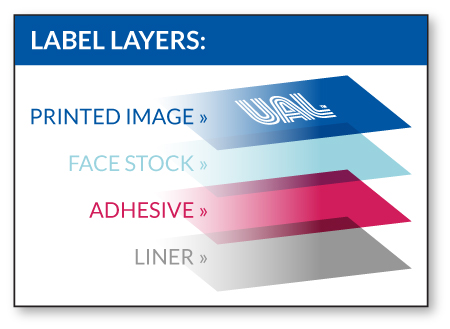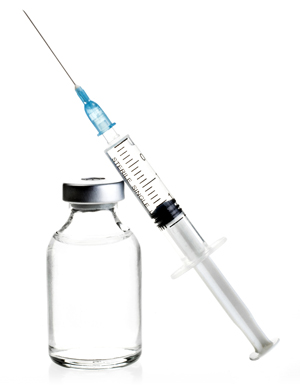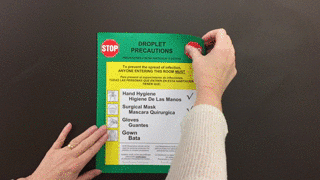Moving patients safely through a healthcare facility requires the effective orchestration of medical care, physical resources, and internal systems. And as crucial as electronic health records, medical devices and medications are to the process there is another item that healthcare providers rely on to get patients from the point of admission to the point of discharge while maintaining quality patient care. In fact, they help guide dozens of diverse clinical care steps throughout the patient journey.
For example. Mylan Pharmaceutical recalled a batch of Insulin due to missing labels on some vials. The absence of information creates a potential health hazard. The fact is, a displaced label can disrupt patient care and potentially impact patient safety. From medication dispensing, IV tubing and communicating critical patient information, to disinfection, sterilization and infection prevention, labels are an essential part of the workflow. But, only if the label works properly. Here’s how to make the right label adhesive selection.
Label Adhesive Selection
 Companies like UAL manufacture stock products with adhesives that work properly for the function they are designed for. But to be sure, before you order, compare the item specifications with your end use application to verify the label material and adhesive are the right fit. In addition, for custom labels, consulting the supplier is a must.
Companies like UAL manufacture stock products with adhesives that work properly for the function they are designed for. But to be sure, before you order, compare the item specifications with your end use application to verify the label material and adhesive are the right fit. In addition, for custom labels, consulting the supplier is a must.
Review the following common healthcare applications to assist your label adhesive selection process.
Medication And Vaccine Storage
Some medications and vaccines require refrigeration or even freezing to maintain their integrity. Ideal storage conditions for refrigerated medications are 35 - 46 °F, and 5 °F or lower when they require freezing. A standard label adhesive works properly when temperatures are above 40 °F. So, using the wrong adhesive can cause the label to fall off. And, unlabeled medications get discarded, causing unnecessary waste and expense.
Cold-Temperature Adhesives
Using a cold-temperature adhesive is essential when medications and vaccines require refrigeration or freezing. These adhesives bond to containers exposed to below normal temperatures and ensure the label remains on the container so the clinical staff can use it.
Sterilization And Disinfecting
Sterilization and disinfection are critical to infection prevention. But, depending upon the medical devices, choosing a method of disinfection can be difficult. However, for items such as surgical instruments, implantable medical devices, and others, there are steps that ensure the item is cleaned and disinfected properly.
High-Temperature Adhesives
Effective sterilization typically includes high temperatures, steam and pressure. Similar to their cold temperature brethren, high-temperature adhesives work in environments where normal temperatures reach 250 °F or higher. Further, autoclave labels provide visual evidence that an item is ready for use. The label remains adhered to the item during the sterilization process and it changes color once the proper sterilization level is reached.
Small Containers
 Small-diameter cylindrical containers are hard to label. In fact, for items such as syringes, ampoules, cartridges, vials, test tubes and more, labels that lift at the edge are a common problem. This peeling can cause the label to stick to other items, fold over on itself obscuring the message, or peel off completely.
Small-diameter cylindrical containers are hard to label. In fact, for items such as syringes, ampoules, cartridges, vials, test tubes and more, labels that lift at the edge are a common problem. This peeling can cause the label to stick to other items, fold over on itself obscuring the message, or peel off completely.
Label Materials And Adhesives For Small Containers
Label construction is particularly critical for small diameter containers. It starts with using materials that adhere properly to a curved or tight radius surface. Flexible materials with good initial contact and the staying power to prevent release at the corners once it is applied are the best choice.
Chemicals And Solvents
Cleaning and disinfecting take place frequently on surfaces throughout a healthcare organization. And whether it’s medical equipment, floors, furniture, walls - or even staff and patient handwashing - chemicals, solvents and soap can obscure essential information on labels.
Label Materials And Adhesives That Resist Chemicals And Solvents
A physical surface coating, or topcoat, helps prevent the defacing that chemicals and solvents can cause when using the wrong label materials. In fact, label topcoats provide excellent resistance to water, solvents, soaps and more. In addition, these coatings increase ink adhesion making essential information stand out.
 Further, repositionable adhesives allow you to remove a label, clean the area underneath and then easily reapply that same label. Infection prevention and hand hygiene signs in bathrooms and on mirrors are common uses for this type of adhesive.
Further, repositionable adhesives allow you to remove a label, clean the area underneath and then easily reapply that same label. Infection prevention and hand hygiene signs in bathrooms and on mirrors are common uses for this type of adhesive.
Wristbands
For a routine or emergency admission, generating a patient wristband is a universal first step. And whether the patient experiences a short stay or one that involves more extensive care, the wristband carries essential information, communicating important medication instructions.
Because wristbands remain on a patient throughout their stay, comfort and security are paramount. They need to remain comfortable and not fall off during showers, baths, examinations and tests. Therefore, the band requires a permanent adhesive that holds the band securely and doesn’t cause adhesive to ooze from the band and stick to the skin.
United Ad Label
There are hundreds of companies that sell labels but very few understand the complexities of label materials, adhesives and the unique applications within the healthcare environment. The UAL team includes label material experts that can help you assess your needs and recommend the right materials that work properly. Contact us to learn more.